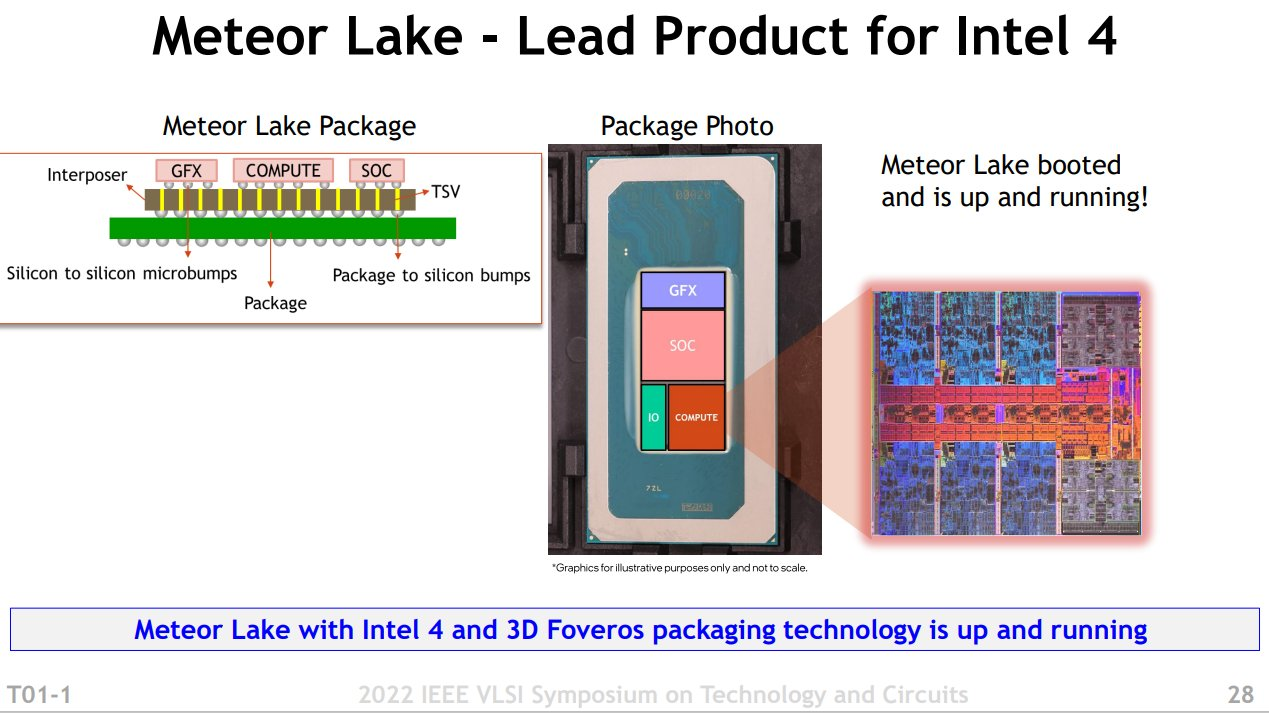Intel goes bold with Meteor Lake CPUs that could take down Apple’s M2
Team Blue’s new lithography seems to be yielding impressive results

Intel has given us our first proper look at its 14th-generation desktop and mobile CPUs, codenamed ‘Meteor Lake’, which are due to launch in 2023. These will be the first processors to utilize the new ‘Intel 4’ process node, which is replacing the Intel 7 design used in the company's current CPUs.
Intel 4 is a 7nm process technology, while Intel 7 was 10nm (yes, we agree that the naming convention is silly). The exciting part is that Intel 4 will use a new type of processor lithography called 'advanced extreme ultraviolet' lithography, or EUV for short. This replaces the conventional deep-UV immersion lithography used in current processor production.
Intel is playing catch-up here, since competitors AMD, TSMC, and now Apple are all already using EUV. Still, the Meteor Lake CPUs look impressive, offering 21.5% improved processor frequency at the same power level or, alternatively, 40% better power efficiency for the same level of performance.
Meteor Lake will also use Intel’s performance and efficiency core design introduced in the current 12th-gen Alder Lake processors, as confirmed by die shots of the new CPUs that show mobile processors with 2P+8E and 6P+8E configurations (that’s P for performance and E for efficiency). The desktop chips will require a new motherboard, as they’ll use the new LGA-1851 socket.

Analysis: Can Intel hope to remain competitive with this new technology?
Given the impressive power efficiency of Apple silicon and AMD’s steadily expanding portion of CPU market share, Intel clearly needs to adapt to remain relevant. The shift over to EUV lithography for processor production won’t be a surprising one for anyone with their finger on the pulse of the CPU race, but will it be enough?
AMD seems committed to the goal of becoming the desktop CPU brand of choice for gamers, with its new 3D V-cache technology (as seen in the amazing Ryzen 7 5800X3D) providing incredible gaming performance. AMD’s next-gen chips are confirmed to feature similarly massive L3 cache memory, meaning that Intel could be left out in the cold by gamers when Ryzen 7000 arrives.
On the other hand, Apple’s M1 and M2 chips have proved to be absolutely incredible in MacBooks, marking Apple silicon as arguably the best processors for productivity. Intel has retained a solid lead over AMD when it comes to laptop processors, but Apple is beginning to look like a serious threat.
Sign up for breaking news, reviews, opinion, top tech deals, and more.
Of course, Intel is gearing up for battle in other arenas too, already entering the GPU market with its Arc graphics cards for laptops. Desktop Arc GPUs are on the way too, but between delays and mixed initial performance, we’re worried that Intel might struggle in the coming years. Will these new CPUs be enough? Only time will tell.

Christian is TechRadar’s UK-based Computing Editor. He came to us from Maximum PC magazine, where he fell in love with computer hardware and building PCs. He was a regular fixture amongst our freelance review team before making the jump to TechRadar, and can usually be found drooling over the latest high-end graphics card or gaming laptop before looking at his bank account balance and crying.
Christian is a keen campaigner for LGBTQ+ rights and the owner of a charming rescue dog named Lucy, having adopted her after he beat cancer in 2021. She keeps him fit and healthy through a combination of face-licking and long walks, and only occasionally barks at him to demand treats when he’s trying to work from home.